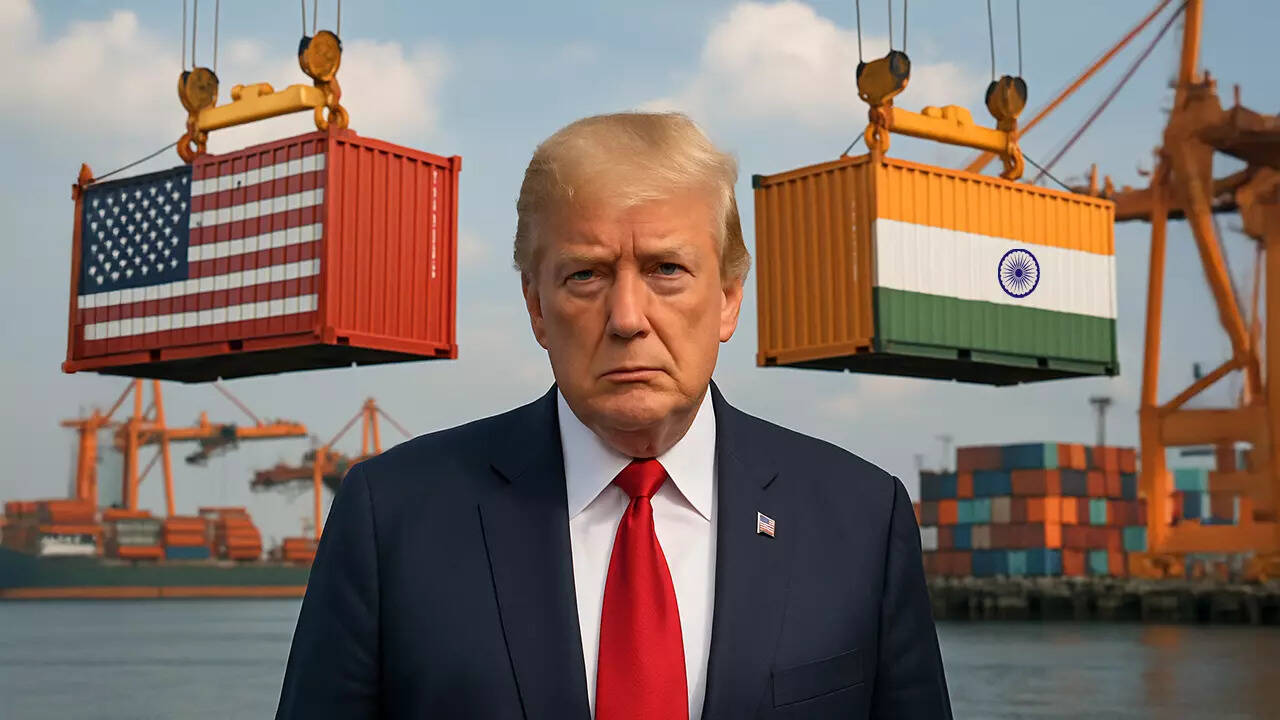A fresh wave of economic tension has emerged between India and the United States as President Donald Trump’s administration officially imposed a 50% tariff on Indian goods, citing New Delhi’s ongoing oil imports from Russia. The decision has triggered alarm across India’s export sectors and raised concerns about the future of strategic and economic cooperation between the two democracies.
The additional 25% duty, announced on August 6 through Executive Order 14329, took effect at 9:31 am IST on August 27, on top of the initial 25% tariffs introduced earlier in the month. With this hike, nearly 66% of Indian exports to the US, worth approximately $86.5 billion in FY25, now face some of the highest trade duties in the world.
Economic Fallout: Key Sectors at Risk
Industry experts warn that the steep tariff increase could severely disrupt Indian exports. According to the Global Trade Research Initiative (GTRI), shipments worth $60.2 billion could be directly affected. Labour-intensive sectors such as textiles, gems and jewellery, shrimp exports, leather, and furniture are likely to be the hardest hit, with projected shipment drops of up to 70%, threatening the livelihoods of millions.
A report from Moody’s Analytics underscores the danger, stating: “The drop in sales to their largest client will hurt.” It cautioned that many Indian firms may be forced to lower prices to stay competitive, risking squeezed profit margins, reduced wages, and lower investments.
Meanwhile, certain sectors such as pharmaceuticals, steel, and smartphones are expected to remain relatively insulated due to existing exemptions and continued strong domestic demand.
India Holds Ground on Russian Oil, Trade Policy
Despite mounting pressure from Washington, Indian officials have made it clear that the country will not alter its energy procurement strategy. Speaking from Moscow, India’s ambassador said the country would continue buying oil from the most cost-effective sources: “Our objective is energy security for 1.4 billion people of India… India’s cooperation with Russia and other nations has helped stabilise the global oil market.”
The Indian government has declined to retaliate with countermeasures but is reportedly preparing a ₹25,000 crore Export Promotion Mission to cushion the impact on exporters. Measures may include trade finance reform, special economic zone (SEZ) incentives, warehousing infrastructure, and expanded global marketing under a “Brand India” initiative.
FIEO Sounds the Alarm
The Federation of Indian Export Organisations (FIEO) has expressed deep concern. President S. C. Ralhan stated that factories in Tirupur, Noida, and Surat have already scaled back operations. “About $47–48 billion worth of India’s exports to the US now face 30–35% cost disadvantages,” he warned, highlighting the urgency of cheaper credit, loan moratoriums, and renewed diplomatic engagement.
PM Modi: “We Will Bear the Pressure”
Prime Minister Narendra Modi, speaking at an event in Ahmedabad, reaffirmed India’s commitment to defending its economic sovereignty: “Pressure on us may increase, but we will bear it all,” he said. Emphasising support for farmers, MSMEs, and local manufacturers, Modi called on citizens and businesses to prioritise Indian-made goods and promised the government would find a path through the current crisis.
The Ministry of External Affairs earlier condemned the tariffs as “unfair, unjustified, and unreasonable,” and reiterated India’s right to pursue energy and trade decisions aligned with national interest.
Relief for In-Transit Shipments
The US Department of Homeland Security (DHS) clarified that Indian goods already “loaded on a ship and in transit” before August 27 would be exempt from the additional 25% duty—provided they are cleared for entry before September 17 and carry the special tariff code HTSUS 9903.01.85.
Global Implications and Strategic Concerns
The escalation has also cast a shadow over US-India strategic relations. The tariff conflict may undermine frameworks like the Quad a security alliance comprising India, the US, Japan, and Australia designed to counterbalance Chinese influence in the Indo-Pacific region.
Economists note that the tariffs could backfire on the US economy as well. A recent State Bank of India (SBI) report suggests that the additional duties could shave off 40–50 basis points from US GDP, while also contributing to elevated inflation through increased input costs and a weaker dollar.
Stalled Trade Talks and Breakdown in Diplomacy
Initial optimism for a bilateral trade agreement (BTA) between the two nations has faded. Despite five rounds of high-level negotiations between March and July 2025, little progress was made. A planned U.S. trade delegation visit to New Delhi in late August was quietly canceled.
Back in February, both Prime Minister Modi and President Trump had committed to expanding bilateral trade to $500 billion by 2030. However, differences over agriculture tariffs, intellectual property rights, and data policies became sticking points. By late July, talks hit a deadlock, with President Trump labeling India’s economy “dead” and citing its energy ties with Russia as the basis for punitive action.
Vice President JD Vance defended the move, describing it as “aggressive economic leverage against Russia.” He added: “Maybe we will apply additional pressure, or maybe we feel like we are making progress, and we will dial that pressure back. We still have a lot of cards left to play.”
Outlook: A Difficult Road Ahead
With trade talks frozen and tariffs now fully implemented, both nations stand to lose. Trade expert Mark Linscott called the development a “lose-lose,” saying that what once looked like a historic trade win for both countries has turned into a missed opportunity.
Former Foreign Secretary Harsh Vardhan Shringla expressed hope for a revival in diplomacy, stating, “Hopefully, we will find a way to conclude a satisfactory mutually beneficial Free Trade Agreement with the United States early rather than late.”
As India considers economic support measures and the U.S. weighs its geopolitical calculus, global markets are watching closely to see whether diplomacy or protectionism will define the next chapter of U.S.-India relations.


